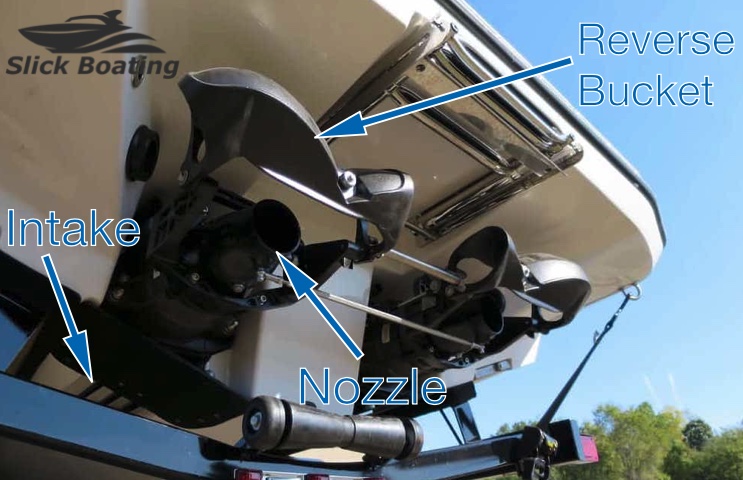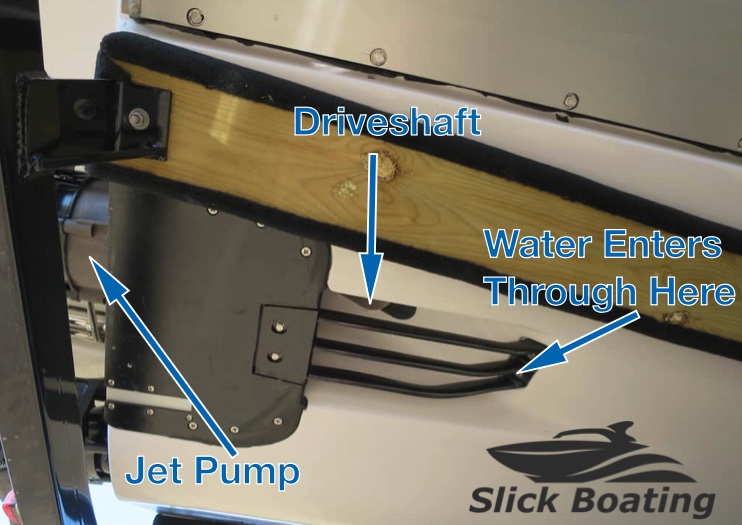The way a jet boat works is the same as how a jet ski works. In fact, most jet boats use jet ski engines.
To demonstrate how a jet boat and their engines/drives work, I’ve compiled pictures and described them in this article.
How A Jet Boat Works

As we can see from picture 1 above, the rear of a jet boat is quite different than other boats. We have the intake, nozzle, and the reverse bucket. This is also a twin-engine jet boat, but a single-engine is very similar.
When you turn the engine on, the impeller that is tucked away starts to spin. Water is sucked up from the intake and pushed out the nozzle.
The nozzle can be moved left or right; this is how you steer the jet boat.
The reverse bucket is what controls the forward and reverse direction of the jet boat. Right now, the buckets are in a neutral position, which is between forward and reverse. If the bucket is up, it would be in the forward position, and if the bucket were down, it would be in the reverse position. You can read more about this in our article about jet boats having reverse and neutral.
This system is much simpler and has less to go wrong when compared to a regular boat. A typical boat will have a transmission that shifts in and out of gears. Thus a regular boat has more moving parts and more things to go wrong.
Jet Boat Intake

Picture 2 above gives us a better look at the intake and pump of a jet boat.
The impeller sucks in water from the intake grate which is the 3 metal bars. The intake grate is for keeping big items like rocks from being sucked up and destroying the jet pump.
Why No Protective Mesh Screen?
Something I get all the time is the question of why don’t they put a mesh screen in front of the intake to stop sand and rocks being sucked up? Since a jet boat is essentially a super powerful vacuum, anything in front of the intake will get sucked up.
The reason why they don’t do a mesh screen is that it would significantly slow down the boat. The more stuff you have in front of the intake, the harder the engine has to work, and the slower you go. Even the slightest of mesh will significantly slow down the boat. The intake grate they have on there is the best compromise they can make.
When The Engine Is On
In picture 2, you can also see part of the drive shaft. The driveshaft is the metal rod that connects the engine to the jet pump.
When it comes to jet boats, if the engine is on the impeller is spinning.
Since jet boats are a lot simpler, they don’t have transmissions that slip the propeller in and out of gears. Jet boats do have neutral, but its the sweet spot between forward and reverse. It’s so fine-tuned that most people don’t even realize their jet boat doesn’t have a “true” neutral.
We can also see the jet pump in picture 2 above. The jet pump is about the size of a small bucket. The jet pump contains the impeller, wear ring, and bearings.
The Wear Ring
It’s a very tight fit between the impeller and the wear ring. It needs to be tight to make a perfect seal to push water through.
The purpose of the wear ring is to protect the jet pump housing from damage as It’s cheaper to replace.
Some manufacturers go with plastic wear rings because it’s cheaper than metal. But some go with metal because it holds up better than plastic. Both are right, but the plastic ones are becoming just as strong as the metal ones, so they’re starting to take over.
Unlike the name “wear” ring, it’s not a wear and tear item. It’s not like your tires on your car that need to be replaced every so many miles. You only replace a wear ring when it gets destroyed. You’ll know you need to replace it when the jet boat doesn’t take off like it used to or shakes like crazy.
Cooling System
At the top of picture 2, we can see a metal plate that is right above the words “Driveshaft”.
That metal plate is unique to Sea-Doo and Scarab jet boats. That metal plate is the radiator as those two boats use a closed-loop cooling system.
This means they don’t take in lake or ocean water to cool the engine. If they’re supercharged, they will still take in water to cool that and the exhaust too, but the engine itself never sees water.
The engine uses coolant, much like your car, to keep it at the perfect temperature. Yamaha jet boats and many other older jet boats use lake or ocean water to cool the engine. This is not bad unless you drive in a lot of saltwater. Saltwater corrodes engines and parts quicker than regular water.
Can You run a jet boat out of the water?
Since all jet boats take in water to cool the exhaust, you can’t run them out of the water for too long.
You want to stay under 30 seconds max.
Going above 30 seconds without having your jet boat in the water will destroy and melt very critical parts.
Note: Sea-Doo does not make jet boats anymore since 2012. Scarab bought the Sea-Doo Jet Boat division and still use Sea-Doo watercraft engines. If you ask me, Scarab is nicer than the old Sea-Doo’s, and they get the perks of Sea-Doo engines, which are the best. Yamaha jet boats are not bad; they do lead in the jet boat market, it’s just that I find Sea-Doo’s engines and tech a lot better.